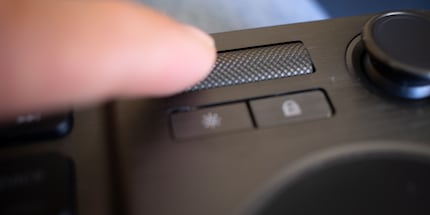

Corsair K83: The keyboard for couch potatoes
Corsair wants to conquer the living room with the K83 keyboard. However, the keyboard with multimedia hotkeys, trackpad and joystick is not convincing.
Can I play with this thing? That's what I ask myself as I hold the Corsair K83 in my hands. The keyboard has a joystick on the right and two mouse buttons. So I'm supposed to use the WASD keys on the left and simulate the mouse with the stick. It's almost like playing a game with a controller. I want to test that right away.

How does it play with the K83 keyboard?
I still have the Rog Strix Scar II notebook from Asus lying around and "Metro: Exodus" on it. Admittedly, playing a shooter with the stick of the K83 keyboard isn't particularly fair. The keyboard can only stink, I think to myself before taking my first steps in post-apocalyptic Russia. And indeed: the controls are so spongy that I give up after five minutes. I cramp up when I press the R button at the back of the keyboard. The stick is so uncomfortable to use that I even long for the N64 controller back.

I'm thinking about what kind of game the stick can be used for. It's definitely out of the question for a strategy game. The mouse is clearly number 1 for that, and I wouldn't want to play a racing or other sports game with it either. WASD is simply not made for that. The only genre I could imagine playing with this keyboard is RPGs. But only if it's not too hectic. So preferably turn-based. For all other games, I consider the K83 in combination with the stick to be unsuitable.
What's in the box?
After so much criticism to start with, I'll take a look at what else is in the Corsair-typical yellow/black box. There are also positive things to say about the keyboard: in addition to the keyboard, Corsair supplies a 1.8 metre micro USB cable for charging, a 2.4 GHz USB wireless receiver and the operating instructions.

The keyboard is kept simple. The cover plate is made of dark grey aluminium. This gives it a classy look. The rounded keys make the keyboard look less aggressive than a gamer keyboard with corners and edges. This means the keyboard blends into any living room without standing out. The size also articles in this: At 38.1×12.5×2.8 centimetres, the keyboard is relatively small and light at 490 grams. I really like the K83.

The grey WASD keys stand out from the other keys. Instead of a numeric keypad, there is a round, capacitive touchpad on the right-hand side, including left and right mouse buttons. Above the pad there is a joystick, a volume control - which also functions as a mute button when pressed - a button for adjusting the backlight and a function lock button. The L button of the mouse is located on the housing frame above the joystick and the R button is located on the back of the housing below the L button.


The input for the charging cable is located on the upper housing frame at the height of the F12 button. The on/off switch is located to the right of the port. Incidentally, Corsair claims a battery life of 1.67 days on a full charge. During my five-day test, I used the keyboard regularly and still had around 50 per cent of battery left.
Features are still available.
Over and over again functions
A keyboard that calls itself an "entertainment keyboard" must have the necessary keys to control multimedia content. Corsair has also thought of this. By pressing the function lock key, you can switch between gaming and media mode. In media mode, the function keys act as hotkeys for multimedia control. They can be used to start the media player and switch between wireless modes and applications, among other things. This is practical and I quickly get used to using the keys.
In gaming mode, the function keys take on their actual function and the joystick acts as a mouse. When gaming, you hold the keyboard like a controller. Thanks to the L and R keys on the top and back of the keyboard, you can use your right hand to control the mouse as well as the joystick.

By pressing Fn + Enter, an LED between the Esc and F1 keys gives you information about the keyboard's charge status. A word about the volume control: Adjusting the volume works very well. However, the same cannot be said for muting: every time I want to mute, I adjust the volume at the same time as I move the slider upwards.

Of course, the keyboard can also be personalised. This works with Corsair's iCue software. In addition to the keyboard layout, you can also configure the advanced gesture control and backlighting. This works perfectly. Corsair is really great when it comes to software control. I have had less favourable experiences with manufacturers such as Roccat or Razer. To make changes, you have to be connected either via wifi or cable. It doesn't work via Bluetooth.
How to type on the 78 keys
Corsair uses so-called "Ultra-low Profile Scissor" switches for the K83 - Corsair's term for scissor switches. This is a modification of rubber domes. In contrast to mechanical switches, this switch technology triggers the signal electronically by pressing on a plastic dome.

As usual for scissor-switch keyboards, the key travel is rather short. I haven't found any exact specifications, but I estimate the key travel to be 2 millimetres.
I'm a fan of mechanical keyboards. That's why I don't particularly like the typing feel on the K83. I miss the satisfying feedback. I was all the more surprised that I got used to the keyboard after a short time. It's definitely better to type on it than on some notebook keyboards. In keeping with its intended use in the living room, the keyboard is very quiet.
Typing on the lap works surprisingly well. The underside of the keyboard housing hardly slips on jeans. I have therefore rarely or never mistyped. Incidentally, you can't raise the keyboard. But that's not necessary, as the keyboard is designed to sit on your lap, and "keyboard legs" only get in the way. The K83 is also slightly raised at the top, which makes typing on the table easy.
The touchpad, well...
The touchpad offers no haptic feedback. I never need the mouse buttons on touchpads. I did use them on the K83 so that I had feedback for my inputs.

Integrating the touchpad into the keyboard is a good idea in itself. Unfortunately, it is only moderately implemented. The pad is too small for me and doesn't always react as it should. Although it is designed for up to four-finger gestures, it reacts very unreliably to inputs with more than one finger. The touchpad doesn't register two-finger gestures very well. Scrolling is a real horror. I wouldn't want to spend an entire office day using the touchpad. However, if you pair the keyboard with the TV, the pad is sufficient - YouTube can still be operated better with the keyboard than with the remote control.
Connection with TV and co.
As I don't have a compatible smart TV or Android TV box, I give the K83 to my colleague Martin Jud to take home. He connects the wireless receiver to his Samsung Smart Connect Box. The keyboard makes contact immediately and he can operate his Smart TV with the keyboard. However, according to Martin, the pointer speed is very slow. Is this due to the keyboard or the Smart TV? He connects the keyboard to the Android box via a wireless receiver. Here, too, the connection works smoothly and the pointer speed is correct. So it must be the older Smart TV. Incidentally, Martin finds the touchpad too small. However, he likes the operation with the stick.

Martin leaned out of the window for you and also tried to pair the K83 with the PS4: Nothing works via stick and the device is recognised via Bluetooth, but is not compatible.
Although I don't see the point in controlling the smartphone with the keyboard and touchpad, I'm also testing whether this works. You can pair the keyboard with two Bluetooth devices and switch between them by pressing the F6 and F7 keys. To pair, press Fn + F6 or F7. Within a few seconds, the K83 connects to my smartphone and I control it with the keyboard and touchpad. Pointless, but somehow funny.

Interesting but too expensive and immature
The K83 from Corsair impresses me with its design and the concept of a keyboard and touchpad in one. The keyboard sits well on the lap and typing is easy, even for a fan of mechanical keyboards. Using the multimedia hotkeys is great fun.
Unfortunately, I can't say the same about the touchpad. It's too small and unreliable. The joystick for gaming is not an option for me. I can't and won't get used to the controls. There may be people who get used to it, but I'm not one of them. If I'm going to use a joystick, then I want a fully-fledged controller.
The K83 is primarily suitable as a pure living room keyboard - you need a mouse for gaming despite the joystick. Would I buy the keyboard? No. That's mainly because I don't want to have a keyboard lying around in my living room. But even if I did, I think over 160 francs is too expensive for a keyboard that I'll only use in front of the telly. And if the most important selling point, the touchpad, doesn't respond properly, I won't anyway.
From big data to big brother, Cyborgs to Sci-Fi. All aspects of technology and society fascinate me.


